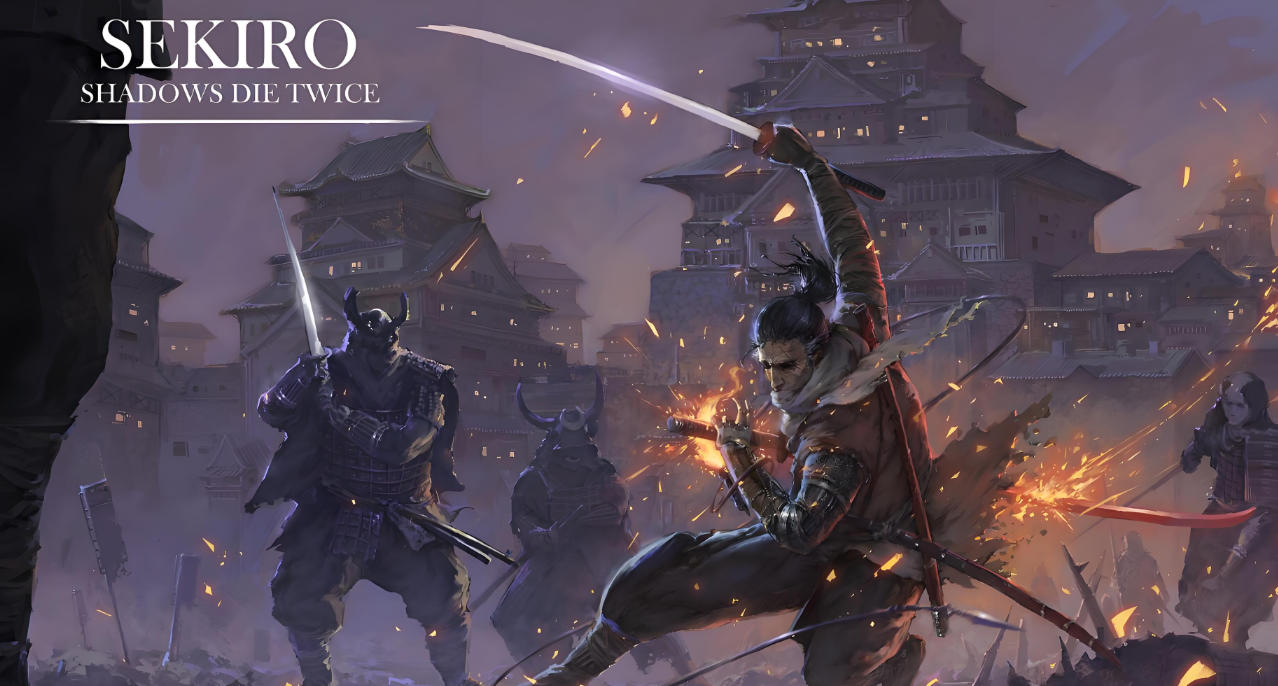Warum Sekiro: Shadows Die Twice gut ist: Ein detaillierter Blick auf Protagonist und Waffen
- von COOLKATANA

Lohnt es sich , Sekiro: Shadows Die Twice zu spielen? Was macht die Geschichte, den Protagonisten und die Shinobi-Prothese so spannend?
Wer Shōnen- Anime mag oder schon mal Hardcore-Actionspiele wie Dark Souls oder Bloodborne gespielt hat, kennt Sekiro: Shadows Die Twice bestimmt. Bei seinem Erscheinen schlug es bei Gamern und Anime-Fans gleichermaßen ein wie ein Lauffeuer. Viele beschrieben es als spielbaren Anime aus der Samurai-Ära, bei dem jeder Kampf puren Adrenalinrausch auslöst!
1. Handlung: Rache, Schutz und Bindungen
Die Handlung von Sekiro erinnert stark an einen Shōnen-Anime – erbitterte Kämpfe, emotionale Entwicklung und ein Protagonist, der durch schwere Zeiten reift. Der Hauptcharakter, Wolf , war einst ein Kriegswaise, der vom Ninja „Eule“ adoptiert und zu einem kalten, skrupellosen Shinobi ausgebildet wurde. Sein Schicksal änderte sich, als er dem jungen Lord begegnete und dessen Gefolgsmann und Beschützer wurde. Von da an drehte sich Wolfs Leben nicht mehr nur ums Töten, sondern auch um die Bürde der Loyalität.
Doch dann schlug das Schicksal zu. Feinde griffen an, der junge Lord wurde entführt, und Wolf verlor im Kampf seinen linken Arm und wäre beinahe gestorben. Gerade als alle Hoffnung verloren schien, erhielt er eine mysteriöse Shinobi-Prothese . Diese schenkte ihm nicht nur ein zweites Leben, sondern auch einen neuen Weg – einen Weg, der von Rache und Pflicht geprägt ist.
Die Geschichte entfaltet sich wie ein Kreislauf von Entscheidungen und Bindungen:
-
Revenge : Wolf jagt Verräter und mächtige Feinde. Jeder Bosskampf fühlt sich an wie ein schicksalhaftes Duell, direkt aus einem epischen Anime-Showdown.
-
Bond : Seine Beziehung zum jungen Lord ist mehr als nur die zwischen Gefolgsmann und Herr – sie fühlt sich familiär, brüderlich an. Diese Bindung treibt die Handlung voran und berührt die Spieler tief.
-
Erlösung : Wolfs Reise handelt nicht nur von der Rache für Verrat, sondern auch von seiner eigenen Läuterung. Einst nur eine Kriegswaffe, erlangt er durch seine Hingabe an den jungen Lord langsam seine Menschlichkeit und sein Mitgefühl zurück.
Was die Fans so fasziniert, ist, dass Sekiro kein festgelegtes Ende hat. Je nach euren Entscheidungen kann die Geschichte ganz unterschiedlich verlaufen. Bleibt ihr dem jungen Lord treu oder wählt ihr einen anderen Weg? Diese Offenheit macht die Analyse des Sekiro-Endes zu einem heiß diskutierten Thema unter den Fans – was ist das „wahre Ende“ und was bedeuten die Entscheidungen wirklich?
Für viele Anime-Fans fühlt sich Sekiro wie ein Shōnen-Anime an, den man spielen kann: ein gezeichneter Protagonist, hin- und hergerissen zwischen Verrat und Verbundenheit, dessen Schicksal von seinen Entscheidungen abhängt. Die zentralen Themen Schutz und Opferbereitschaft machen es unvergesslich.
2. Der Protagonist Wolf: Eine kalte Fassade, ein feuriges Herz
Wolf besitzt alle Eigenschaften eines fesselnden Anime-Protagonisten – er ist schweigsam, stoisch und doch voller Entschlossenheit. Seine Anziehungskraft geht weit über seine Kampffähigkeiten hinaus; sie liegt in seiner Persönlichkeit und seiner Entwicklung.
-
Stoisches Äußeres : Wolf spricht selten und zeigt kaum Gefühle. Ob im Kampf gegen normale Gegner oder monströse Bosse – er bleibt ruhig und gelassen. Diese eisige Aura fesselt die Spieler sofort und weckt in ihnen den Wunsch, seine Vergangenheit zu ergründen.
-
Unerschütterliche Loyalität : Verwechseln Sie Schweigen nicht mit Gleichgültigkeit – wenn der junge Lord in Gefahr ist, setzt Wolf alles aufs Spiel, sogar sein Leben. Ihre Bindung verkörpert das klassische Motiv der „Macht der Freundschaft“ und verleiht den Kämpfen emotionale Tiefe.
-
Innere Konflikte : Auf seiner Reise begegnet Wolf nicht nur tödlichen Feinden, sondern auch moralischen Dilemmata. Er hinterfragt seine Entscheidungen und den Preis seiner Opfer. Diese Kämpfe formen ihn zu einem vielschichtigen, menschlichen Helden, sodass die Spieler seinen Schmerz und seinen Triumph nachempfinden können.
-
Klassisches Shinobi-Design : Wolfs Shinobi-Ausbildung, kombiniert mit der einzigartigen Shinobi-Prothese , verleiht seinem Kampfstil einen unverwechselbaren und stilvollen Charakter. Seine Kämpfe vereinen taktische Präzision und explosive Fähigkeiten und bieten Spielern gleichermaßen Herausforderung und Nervenkitzel.
Aus diesem Grund suchen viele, die nach „ Sekiro-Protagonistenanalyse “ suchen, nicht nur nach Spielmechaniken oder Waffen – sie wollen verstehen, wie dieser schweigsame, kalte Krieger sich von einem verlorenen Waisenkind zu einem legendären Shinobi entwickelte und wie seine Loyalität und seine feurige Entschlossenheit seinen Weg prägen.
Wolfs Charakter gleicht dem Protagonisten eines meisterhaften Animes – kühl und doch leidenschaftlich, stoisch und doch zutiefst menschlich. Jeder Kampf und jede Entscheidung offenbart einen Mann, gezeichnet von Narben, gefestigt von Loyalität und getrieben von einem unerschütterlichen Willen zum Schutz.
3. Sekiros Waffensystem: Die perfekte Kombination aus Shinobi-Prothese und Katana Kusabimaru
Wenn sich die Geschichte von Sekiro wie ein Hardcore-Anime anfühlt, dann ist sein Waffensystem das reale „Arsenal des Hauptcharakters“. Jedes Ausrüstungsteil steckt voller Spannung und Strategie und macht die Spieler süchtig.
-
Katana Kusabimaru – Wolfs Kampfseele
Kusabimaru ist Wolfs Hauptwaffe. Obwohl sie schlicht aussieht, fast wie ein gewöhnliches Einhandschwert, entfaltet sie im Kampf ihre ganze Kraft! Jeder Hieb, jede Abwehr und jeder Gegenangriff hat Gewicht und Rhythmus, als würde man ein Duell auf Leben und Tod aus einem Anime nachspielen. Ob gegen normale Samurai oder gewaltige Bosse – das Design, bei dem ein Schlag ausgeführt und ein Block ausgeführt wird, vermittelt das wahre Gefühl der Schwertkunst und belohnt Präzision mit immenser Befriedigung. Kusabimaru ist nicht nur eine Waffe – sie verkörpert Wolfs Philosophie: Sieg durch Gelassenheit, durch die Balance von Kraft und Schnelligkeit. -
Shinobi Prothese – Das ultimative transformierbare Werkzeug
Die Shinobi-Prothese kann ihre Funktionen nach Belieben wechseln: Shuriken, Flammenwerfer, Axt, Speer, sogar ein Enterhaken … im Grunde ein „Cheat-Code“ für den Hauptcharakter. Im Kampf kannst du Gegner mit Shuriken belästigen, Verteidigungen mit Axt oder Speer durchbrechen oder akrobatische Manöver mit dem Enterhaken ausführen. Ihre Vielseitigkeit erweitert Strategie und Freiheit enorm und lässt Spieler nicht nur den Nervenkitzel eines Actionspiels erleben, sondern auch die List und den Einfallsreichtum von Wolf als Ninja. -
Kampfstil & Spielfreiheit
Die Kombination aus Kusabimaru und der Shinobi-Prothese verleiht Wolf seinen einzigartigen Kampfstil: Man kann frontal angreifen oder lautlos meucheln; präzise mit einer Hand parieren oder Kombos aneinanderreihen und dabei parkourartige Manöver ausführen. Jeder Kampf fühlt sich an wie eine actiongeladene Anime-Kampfszene, ist aber gleichzeitig tiefgründig taktisch – kein Wunder, dass das „ Sekiro-Waffensystem “ unter den Fans so heiß diskutiert wird. -
Fandom-Fokus
Dank der Einzigartigkeit von Kusabimaru und der Shinobi-Prothese suchen Fans ständig nach „ Sekiro Katana-Guide “, „ Sekiro Prothesen-Werkzeugliste “ und „ Sekiro Waffen-Build-Tipps “. Es geht nicht nur um besseres Gameplay, sondern darum, vollständig in Wolfs kalte und zugleich brillante Persönlichkeit einzutauchen. Jeder Hieb und jeder Ausrüstungswechsel fordert nicht nur Reflexe, sondern auch taktisches Denken und macht Sekiro damit zu einem seltenen Meisterwerk des Action-Genres.
Kurz gesagt, die Kombination aus Kusabimaru und Shinobi-Prothese steigert nicht nur die Kampfintensität – sie macht dich zu Wolf: dem kaltblütigen Ninja mit einem feurigen Herzen, dessen jeder Schlag Strategie und Heldentum verkörpert.
Handgefertigtes Katana-Schwert mit Untoten-Schnitt, Sekiro: Shadows Die Twice, japanisches Samurai-Schwert, Klinge aus gehärtetem violettem Federstahl, durchgehender Erl
Sekiro Shadows Die Twice Replika-Schwert – Funktionelles Katana aus 9260er Federstahl
Handgefertigte Replik des Sekiro Shadows Die Twice Schwertes mit roter Klinge (Untoten-Katana)
4. Sekiros Kampfsystem: Eine Mischung aus Nervenkitzel und Herzschmerz
Wer Sekiro gespielt hat, weiß es: Das Kampfsystem ist der Inbegriff von Action-Gameplay und vereint Nervenkitzel mit brutaler Schwierigkeit. Es fühlt sich an wie ein Hardcore-Shōnen-Anime.
-
Körperhaltungssystem – Die Seele des Kampfes
Anders als in typischen Actionspielen, bei denen es vor allem um den Verlust von Lebenspunkten geht, legt Sekiro den Fokus auf das Haltungssystem . Sowohl du als auch deine Gegner verfügen über Haltungsleisten; nur durch präzises Abwehren und Kontern kannst du die Deckung eines Gegners durchbrechen. Sobald sie zerbricht, führst du einen vernichtenden Schlag aus. Diese Mechanik macht jeden Kampf strategisch, jede Bewegung bedeutsam – wie etwa das finale Comeback des Protagonisten gegen einen Boss, das explosiv und befriedigend ist! -
Bosskämpfe – Brutal und legendär
Die Bosse sind legendär, jeder einzelne ein vorherbestimmter Showdown wie aus einem Anime. Das Duell gegen Genichiro Ashina beispielsweise testet nicht nur dein Können, sondern auch deine Fähigkeit, die Angriffsmuster deiner Gegner zu lesen. Und dann ist da noch Isshin Ashina , der Endboss, der deine Reflexe, dein Urteilsvermögen und deine Geduld bis zum Äußersten fordert. Obwohl der Sieg gnadenlos ist, schenkt er dir ein unvergessliches Triumphgefühl. Fallen, wieder aufstehen und es erneut versuchen – dieser Kreislauf aus Schmerz und Freude lässt dich vollkommen in die Welt der Ninjas eintauchen. -
Strategie trifft auf Umsetzung
Kämpfe sind mehr als nur wahlloses Tastendrücken – sie erfordern ein ausgewogenes Verhältnis von Planung und Reaktion. Du kannst frontal angreifen, Prothesen für Fernangriffe nutzen, dich an Feinden vorbeischleichen oder akrobatische Ausweichmanöver einsetzen. Jede Begegnung ist ein psychologisches Spiel, das Spieler zwingt, ihre Gegner mit Köpfchen und Geschick zu bezwingen. -
Die Freude und der Schmerz des Anfängers
Das erklärt, warum Neulinge, die nach „ Sekiro Anfängerleitfaden “, „ Sekiro Bosskampf-Tipps “ oder „ Sekiro Haltungssystem erklärt “ suchen, sich oft darüber beschweren, wie brutal die ersten Bosse sind. Doch sobald sie das Abwehren beherrschen und ihren ersten Haltungsbruch in einen Todesstoß verwandeln, ist der Adrenalinrausch so überwältigend, dass sie einfach rufen müssen: „Ich hab’s geschafft – ich bin der Shinobi!“
Sekiros Kampfsystem ist insgesamt eine makellose Mischung aus Schmerz, Nervenkitzel und Strategie . Dank der geschickten Verknüpfung von Haltungsmechaniken, Todesstößen, Prothesen und Bosskämpfen ist jeder Kampf lohnend und lässt dich vollständig in Wolfs Rolle schlüpfen: nach außen hin kühl, aber im Kern kämpft er mit allen Mitteln, um seine Bande und seine Ehre zu verteidigen.
5. Lohnt es sich, Sekiro zu spielen? Echte Fan-Eindrücke
Als echter Sekiro- Fan sage ich es mit voller Überzeugung: Wenn du Anime-artiges Storytelling, adrenalingeladene Kämpfe und knallharte Herausforderungen liebst, ist Sekiro ein absolutes Muss. Nach dem Durchspielen wirst du die wahre Bedeutung von „Shinobi-Bindungen und Beharrlichkeit“ vollends verstehen.
-
Für Geschichtenliebhaber
Wer auf tiefgründige Geschichten und Charakterentwicklungen steht, findet bei der Suche nach „ Sekiro Story erklärt “ unzählige Diskussionen. Die Bindung zwischen Wolf und dem göttlichen Erben, die Geheimnisse der Shinobi-Prothese und die miteinander verwobenen Themen Rache und Schutz – jedes Kapitel liest sich wie ein packender Anime. Von dem Moment an, als Wolf seinen Arm verliert und die Prothese erhält, lässt einen die Geschichte nicht mehr los. -
Für Kampfsportbegeisterte
Wer sich nach spielerischer Perfektion sehnt, sollte sich Sekiros Kampfsystemanalysen, Bossstrategien und die Möglichkeiten zum Bau von Prothesenwerkzeugen nicht entgehen lassen. Das Haltungssystem, die Abwehr von Angriffen und die tödlichen Schläge fordern sowohl Verstand als auch Reflexe heraus. Bosse wie Genichiro und Isshin können einen zwar an den Rand der Verzweiflung bringen, doch ihr Sieg schenkt unvergleichliche Befriedigung. -
Für Sammler
Abseits des Spiels selbst sind Sekiro-Sammlerstücke äußerst begehrt. Von Kusabimaru-Repliken von Katanas und Actionfiguren bis hin zu Armprothesen – die Fangemeinde bietet eine riesige Auswahl an Merchandise-Artikeln. Ob als Ausstellungsstücke im Regal oder als Requisiten für Cosplay, sie fangen Wolfs Aura und die raue Ästhetik des Ninja-Lebens der Sengoku-Zeit perfekt ein.
Wer sich fragt: „ Lohnt es sich, Sekiro zu spielen? “, dem sei die Antwort ganz klar gegeben: Ja! Ob Story, Kampfsystem oder Sammelobjekte – das Spiel bietet unvergleichlichen Spielspaß. Wolfs Entwicklung, seine Loyalität und seine Entschlossenheit machen jede Entscheidung und jeden Kampf unvergesslich – eine Reise, die ihr nicht bereuen werdet.
Abschluss
Sekiro: Shadows Die Twice ist wie ein knallharter Sengoku-Ninja-Anime zum Spielen: eine Geschichte über Bindungen und Entscheidungen, ein stoischer und doch loyaler Held, explosive Kämpfe und Waffen, die eines Animes würdig sind.
Wer eine feurige Reise von Rache zu Schutz erleben möchte, wird von Sekiro von Anfang bis Ende gefesselt sein!











